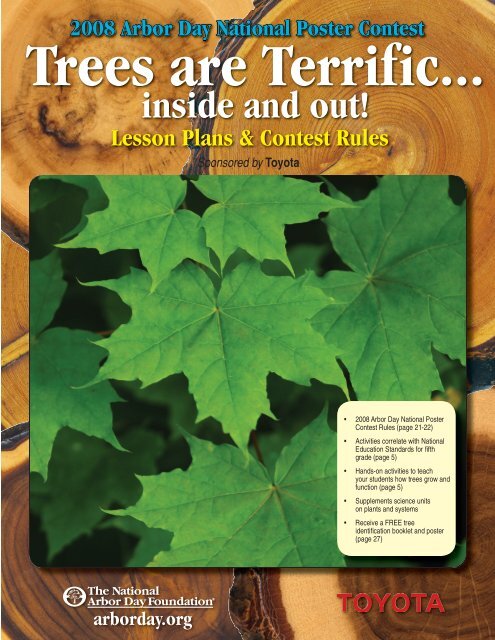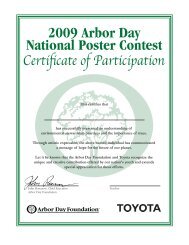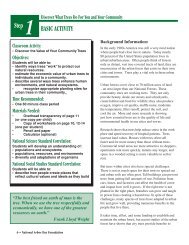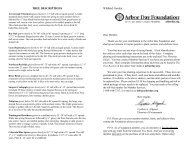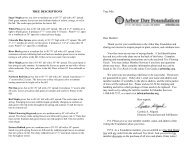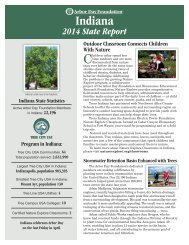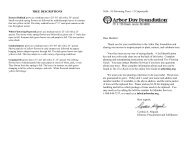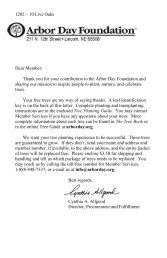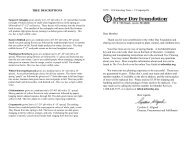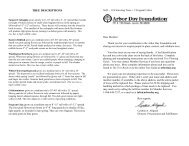Create successful ePaper yourself
Turn your PDF publications into a flip-book with our unique Google optimized e-Paper software.
Table of ContentsWelcome ......................................................................................................................................................................................... 2Activities Guide Overview ................................................................................................................................................................. 4Discover how trees grow and function .........................................................................................................5-20Basic activity ...................................................................................................................................................... 5Extension activities .......................................................................................................................................... 19Step 2Step 1Celebrate <strong>Arbor</strong> <strong>Day</strong> .........................................................................................................................................28Create a poster ...........................................................................................................................................21-27Instructions and listing of national prizes ....................................................................................................... 21<strong>Arbor</strong> <strong>Day</strong> National Poster Contest Rules ......................................................................................................... 22<strong>Arbor</strong> <strong>Day</strong> National Poster Contest School Winner Report Form ...................................................................... 23Participation Certificate (also online at arborday.org/certificates) ................................................................... 24School Winner Certificate (also online at arborday.org/certificates) ................................................................ 25Poster Contest State Coordinators .................................................................................................................... 26Poster Contest Survey (to be filled out or submitted online) ........................................................................... 27Step3Here is what fifth grade teachers who reviewed the 2008 Poster Contest Lesson Planshad to say:• “This a great activity by bringing in the movement and sounds. Students can‘see’ and be a part of a living system.”• “Great introductory activity, highly motivating.”• “Love this! I’m always looking for lessons that include movement and thoughtfor my students.”National <strong>Arbor</strong> <strong>Day</strong> <strong>Foundation</strong> • 3
As Easy as 1 - 2 - 3!Step1Discover how trees grow and functionLearning Objective:• Students will identify structural components of atree, be able to explain how these components helpa tree grow and function, illustrate the process ofphotosynthesis, and reflect on the benefits treesprovide to the environment.Basic Activity• Role-play the growth process of a treeExtension Activity• Searching for Stoma• Leaf TranspirationStep2Create a posterLearning Objective:• Students will create a poster that reflects their understanding of how trees grow,function and benefit the environment.Step3Celebrate <strong>Arbor</strong> <strong>Day</strong>Learning Objective:• Students will plan and participate in an <strong>Arbor</strong> <strong>Day</strong>celebration.4 • National <strong>Arbor</strong> <strong>Day</strong> <strong>Foundation</strong>
Step1Discover how trees grow and functionBASIC ACTIVITY - Role-play the growth process of a treeClassroom Activity:• Students will role-play the growth process of a youngtree to become familiar with the structural componentsof a tree and learn how these components help the treefunctionObjectives:Students will be able to:• name several environmental benefits and products treesprovide• identify structural components of a tree and explain howthese components help a tree function• describe the process and major components involved inthe process of photosynthesisTime Recommended:• 60 - 90 minutesMaterials Needed:• Photocopied student handouts on pages 11-13• One or two examples of tree fruits/seeds (i.e. acorn,walnut, apple with seeds)• Several samples of bark, if available• Small plant in pot (optional)• Hand lenses (optional)• Approximately 6 foot piece of ribbon or yarn• Pencil and paper• Tree cross-section or picture of a cross section• 2 small bottles of water• 6 small packets of sugar• Red, blue, green, yellow & brown construction paper• Tree Labels on pages 18 & 19 photocopied, cut andpasted onto strips of colored construction paper• Ball of string or twine• Paper clips (one per label)National Science Standards Correlation:Students will develop an understanding of:• structure and function in living systems• populations and ecosystems• populations, resources and environmentsInstructional Sequence:Concept #1 - <strong>Trees</strong> benefit people and theenvironment in many waysStart the classroom discussion by reading Paragraph #1.Paragraph #1Recently I read a story in the newspaper about acommunity that was experiencing environmentalproblems. The stream in the city was always brownfrom soil erosion after a heavy rain. The air washazy because of the smog. The city’s buildings andpavements reflected so much heat that the summertemperature was uncomfortably hot. The people inthe city were concerned and were looking for someway to improve conditions in their community. Abright young student told the city leaders she had asolution to their problem. She had an invention thatcould clean the air, produce fresh oxygen, preventsoil erosion, cool the sidewalks, muffle traffic noise,and could last many years with just a little c<strong>are</strong>.And, she added, it could operate on solar powerfrom the sun.Ask students if they think, with modern technology,such an invention is possible. Could there really besomething that would clean and cool the air, makefresh oxygen, prevent soil erosion, and muffle noise– all operated on solar energy? If so, what do theythink something like this might cost? Allow students torespond without comment.After students have had an opportunity for input,continue by reading Paragraph #2.Paragraph #2The young student went on to describe otherfeatures of the unique invention. She said thatalong with helping the environment, this inventionwould provide homes and food for birds andother animals, kids could climb on it, and itwould make the community more attractive. Ifmany of these things were available some couldeventually be made into things people could use...National <strong>Arbor</strong> <strong>Day</strong> <strong>Foundation</strong> • 5
Step 1:Discover how trees grow and function - BASIC ACTIVITYlike paper, houses, baseball bats, or even medicine.And when it was no longer useful, this invention wasbiodegradable or could be used for fuel. She saidthis thing was not new, but something that had beenaround for years.Ask students: Can you guess what “invention” this youngstudent was referring to?By now many students may have guessed that you havebeen describing a tree. If students <strong>are</strong> still mystified,continue to give more clues (i.e. This invention is aliving thing, it bears fruits and seeds, it grows, it providesshade, etc.) If students still do not realize you have beendescribing a tree, you may need to spend extra timeas you introduce and go through each of the followingconcepts.With student input, do a quick review of the benefits weget from trees. List the benefits on the board. Encouragestudents to add additional environmental benefits or treeproducts to the list.Write the following questions on the board. Explain theyhave just discussed the first question, but by the end ofthe lesson, they should know the answer to all thesequestions.1. How do trees benefit the environment?2. How does a small seed grow into a huge tree?3. What <strong>are</strong> the important parts of thetree that work together to help the treegrow and reproduce?4. How does a tree use sunlight to make itsown food?Concept #2: A tree has many interdependentstructural components that <strong>are</strong> essential for thetree to grow and reproduce.Starting as a SeedHold up an acorn, or any available tree seed. Tellstudents that a tree starts very small...as small as a tinyseed. This seed could someday grow into a tree tallerthan a house. A tree produces many seeds, but not allseeds fall where conditions will allow them to grow.Only a few seeds actually survive and grow to a tree.But when a seed lands in a good location...and raincomes at the right time...the little seed softens and beginsto grow.Ask students what they think happens first when a seedstarts to grow.RootsTell students that when a seed germinates (starts to grow),the first thing the seed sends out is a tiny root to hold itsposition in the soil and start drawing in water.Concept #1: <strong>Trees</strong> benefit people and the environment in manyways.Concept #2: A tree has many interdependent structuralcomponents that <strong>are</strong> essential for the tree to grow and reproduce.Concept #3: Through a process called photosynthesis leaves takein carbon dioxide and water, and using chlorophyll and sunlight,create oxygen and make a sugar food that feeds the tree.6 • National <strong>Arbor</strong> <strong>Day</strong> <strong>Foundation</strong>
Examples of Root GrowthR<strong>are</strong>ly trueMore commonly trueAs a tree grows larger it develops several kinds of roots.A few trees have long taproots that go deep down intothe soil, but most trees have shallow, lateral roots that liecloser to the surface of the ground. About 85% of a tree’sroots <strong>are</strong> within the top 18” of soil! Most trees <strong>are</strong> likelyto have roots extending out about one and a half to twotimes the branch spread. (See illustration)Make a similar quick-sketch picture of a tree and itsspreading root system on the board to give students asense of the lateral, rather than downward, spread of theroot system.Have students work as pairs. One student in each pairshould extend their arms like branches, standing ontiptoe with feet together, and pretend to be a tree. Askwhat they think would happen if the wind came up?The other student in each pair should simulate this bysupporting their partner with one hand and giving theirpartner a very gentle push with the other hand. Repeatthe demonstration with the student standing with legsslightly spread and feet flat on the floor. Ask studentswhat they think this activity showed. Confirm that onefunction of the roots is to keep the tree anchored in thesoil so it doesn’t fall over. In some ways, tree roots <strong>are</strong>like your feet – when they spread out, the tree is morestable.The taproot and lateral roots <strong>are</strong> large, hard and woody;they contain cells for the storage of sugar, just like thetrunk and branches. But as these larger roots spread out,they branch into smaller and smaller roots called rootlets,fine fibrous roots covered with tiny root hairs. These roothairs suck in water and nutrients from the soil that thetree needs to live. These fibrous roots cling firmly to thesoil in order to better absorb water and nutrients. Bydoing so, the roots also hold the soil in place and protectit from erosion. Tree roots <strong>are</strong> tenacious in their searchfor moisture and nutrients. Where soft earth is lackingthey will move through clay and gravel, and even intorock.Root Activity (optional) - A first hand observation of aroot is important. Even though a smaller plant won’thave the same woody root structure as a tree it is worththe time to study its roots.Remove a small plant from the pot. Point out to studentshow the soil remains packed around the bottom of theplant. Ask them to speculate why that is so. (The roots <strong>are</strong>holding the soil in place.) Ask students to think of waysplants could be used to prevent soil erosion. Shake thesoil off the roots. Break off sections of root and allowchildren to look at them with a hand lens. Ask studentsto make observations about the roots they examine. Canthey see the tiny root hairs? How <strong>are</strong> the plant roots likethe tree roots just discussed; how <strong>are</strong> they different?Ask students if they think the plant can survive withoutits roots. Put the plant and soil back in the pot or set theplant in container of water and observe it over the nextseveral days to see what happens after roots have beendamaged.National <strong>Arbor</strong> <strong>Day</strong> <strong>Foundation</strong> • 7
Step 1:Discover how trees grow and function - BASIC ACTIVITYAs an extension activity, if time permits, take students ona walk and notice the above ground tree roots that maybe visible, especially in an urban setting. Discuss theirsimilarity to the branches on the same tree. Are the rootscausing problems with the cement or ground aroundthem? Observe small trees or plants rooting in cracks inthe sidewalks. Have students make observations about thestrength of roots.Trunk Form and FunctionMany of these internal tree parts will be new to yourstudents. Background information is included for all the treeparts to sh<strong>are</strong> as you look through the Student Handouts 1& 2 together (pages 11 & 12). Encourage student questionsand observations as you examine the Tree Cross-Sectionillustration on the handout. Student Handout #3 on page 13contains a vocabulary list of bolded words and a rubric.Background information: Every tree trunk resembles acylinder whether long and slender or short and stout. Thetall, stately trunk of the eastern white pine and the small,short trunk of the redbud both perform the same function.A tree trunk is largely composed of a compact mass oftiny tubes made of cells. Great numbers of these hollowtubes serve as pipelines that conduct water and nutrientsabsorbed by the roots up to the leaves. These <strong>are</strong> calledxylem cells, or sapwood, and they make up what wecommonly refer to as the wood of the tree. Others cells,called phloem, or inner bark, carry the sugar food madeby the leaves back down to the living parts of the tree.Located between these two pipelines is the cambium, thegrowing layer of the tree. Deep in the center of moremature trees <strong>are</strong> old xylem cells that have become thickand solid, providing strength for the tree. This part ofthe tree is referred to as the heartwood. Surrounding theoutside of the trunk and branches <strong>are</strong> old dead phloemcells commonly called outer bark that serve as a protectivecovering for the tree.CambiumIn a layer only one cell thick that completely encloses theentire trunk, limbs, and all the branches, rests the tree’sability to grow and create new cells. This layer is called thevascular cambium. Some new cells formed in the cambiummove outward to become phloem cells, others moveinward to become xylem cells. Essentially this layer createsnew wood on one side of itself and new bark on the other.As it increases the tree’s internal girth the cambium movesoutward, pushing the bark before it, leaving thewood behind.Cambium activity – Ask one student to come tothe front of the room and extend his or her armsperpendicular from their body, pretending to be atree. Tie a ribbon around the child’s waist. Ask theclass to predict, if this was actually a tree with aribbon around it, what might happen to the ribbon.Will it move higher (further up from the ground) asthe tree grows?After students have had a chance to guess, explainthat the answer is no. <strong>Trees</strong> grow in diameter fromthe inside out, but tree height comes from newgrowth at the very tips of the branches...so theribbon would remain at the same height, no matterhow tall the tree might grow. If the scarf were left inplace for a long time however, the cambium wouldkeep adding to the width (thickness) of the tree.That would eventually either break the ribbon orforce the bark to actually grow around it. Should thathappen it might injure the food-transportation systemand eventually kill the tree.Explain that’s why people should never tie anythingpermanently around the trunk of a tree or nailanything to a tree.8 • National <strong>Arbor</strong> <strong>Day</strong> <strong>Foundation</strong>
arborday.org/postercontestXylemThe cell layer interior to the cambium is called xylem orsapwood. Each spring and summer the cambium makesnew xylem cells, adding new layers of wood aroundlayers laid down in years past, increasing the width ofthe tree. The wood formed in the spring grows fast andis lighter-colored because it consists of large cells createdwhen there is plenty of moisture. The wood formedin summer grows more slowly and is darker coloredbecause there is less available moisture so the cells <strong>are</strong>smaller and more compact. When a tree is cut, the layersappear as alternating rings of light and dark wood. Countthe dark rings, and you know the tree’s age.PhloemXylemDendrochronology is the study of a tree through itsannual growth rings. Scientists not only use these ringsto determine the age of the tree, but they can also getinformation about the climate, the spacing of trees andthe presence of fire around the individual tree. A widering often indicates that plenty of moisture was availablethat year. Rings that <strong>are</strong> very close together often suggestthere was a drought.The xylem is the “up” system in the tree. The cells inthe xylem layer fuse to form uninterrupted tubes thatconduct the moisture and nutrients from the roots upthrough the trunk to the leaves. Consider a 200’ tall tree.Imagine the challenge of raising water that high withouta giant pump, but trees have managed to adapt.Because water molecules have a cohesiveness or atendency to stick together, there is a constant, continuous“string” of water in each tube of xylem cells. Watercontinually evaporates or is transpired out of the leaves.This water shortage in the leaves results in a tremendouspull on the water in the xylem tubes causing the water tomove up through the xylem into the leaves.Xylem Activity - Have students examine the tree crosssectionand figure the age of the tree when it was cutdown. If an actual cross-section is not available, a pictureof one can be viewed and/or printed atarborday.org/annualrings.HeartwoodThe center, supporting pillar of the tree is calledheartwood. Although it is non-living it will remain strongand will not decay as long as the outer layers of thetrunk <strong>are</strong> intact. As a tree grows in diameter the inner,older xylem layers fill with gum and resin and hardenBark Cambium Heartwoodproviding support to the tree as it grows taller and wider.The vast majority of a living tree (99%) is nonliving cellsthat provide structural support rather than active fluidconduction.PhloemThe cell layer exterior to the cambium is called phloem,sometimes referred to as inner bark. It is the “down”transport system in the tree. Only a few cells wide, itcarries the jelly-like sugar food produced in the leavesthroughout the tree. Phloem cells <strong>are</strong> stacked one on topof the other. Their connecting cell wall is perforated likea strainer. When one cell is full of the jelly-like food thecontents ooze slowly into the next. Eventually the foodfinds its way down from the leaves to the roots. Whenphloem cells die they become part of the outer protectivelayer of bark.BarkThe outer layer of the trunk is covered with bark. Treebark can be smooth, rough, or scaly. Although barkmay look different from tree to tree it serves the samepurpose – to protect the tree from injury and disease,somewhat like your skin. Often bark has bad-tastingchemicals, which discourage hungry insects or gnawingrodents from harming the tree. Some trees have verythick bark, which prevents damage from fire.Every year the cambium layer produces new phloemcells that <strong>are</strong> squeezed between last year’s phloem cellsNational <strong>Arbor</strong> <strong>Day</strong> <strong>Foundation</strong> • 9
Step 1:Discover how trees grow and function - BASIC ACTIVITYand the cambium. Outer bark is formed as old phloemcells die and <strong>are</strong> forced outward. When smooth,tight-fitting young bark is unable to expand or stretchbecause of the addition of new cells the bark maycrack, split, or be shed from the tree. Each tree specieshas a characteristic way of expanding or breaking itsbark forming patterns by which many trees can beidentified.Bark Activity – Look at samples of different kinds of treebark. Notice the thickness of the bark and examineit for evidence of how the bark expanded and grewfrom the inside out. You may wish to use pencils andpaper to do bark rubbings that will reveal the differentpatterns in tree bark.Concept #3: Through a process calledphotosynthesis leaves take in carbon dioxide andwater, and using chlorophyll and sunlight, createoxygen and make a sugar food that feeds the tree.LeavesBackground information:Leaves come in many shapes and sizes and providethe easiest means of identification of an individualtree. Some <strong>are</strong> needle-shaped, some <strong>are</strong> flat andthin. Some leaves remain on the tree throughout theyear (evergreen) and some leaves <strong>are</strong> shed annually(deciduous). But regardless of size or shape, all leaveshave the same function: they create the sugar food thatfeeds the tree and, through the web of life, feeds allother living things. The amazing process that makesthis possible is called photosynthesis. Refer to theillustration on Student Handout #2 as you discuss thisprocess with students.Photosynthesis is a combination of “photo” meaning“produced by light” and “synthesis” which means“putting together parts or elements to make a whole.”Photosynthesis occurs only in plants that contain a greensubstance called chlorophyll. Chlorophyll is the enablerfor the photosynthetic process. During photosynthesis,chlorophyll, carbon dioxide, water and light-energy fromthe sun <strong>are</strong> used to make a sugar-like food that becomesthe basic source of energy for the plant and other livingthings. While making this food, the green plant gives offoxygen and water vapor into the air.Carbon dioxide (CO 2) is exhaled by animals, created bymicroorganisms through the process of decomposition,and released during the combustion of fossil fuels. In theleaf of a green plant, carbon dioxide comes in contactwith water (H 20) and nutrients that have been drawn upfrom the soil by the roots of the plant. In the presence ofsunshine, chlorophyll within the green leaf combines theCO 2and H 20. This combination results in the creationof a sugar food called glucose (C 6H 12O 6) that providesenergy for the plant and all animals that eat that plant,or eat the animal that ate the plant. Not only <strong>are</strong> plantsthe base of food chains upon which all animals depend,plants also produce oxygen a gas that all animals(including humans) need to survive.Carbon dioxide enters the leaf and oxygen exits theleaf through tiny holes called stoma, usually found onthe undersurface of the leaves. At the same time, wateris also released in a process called transpiration. Mostplants in temperate climates transpire about 99% of thewater the tree has taken in by their roots. The planttranspiration helps modify the temperature and humidityof the surrounding <strong>are</strong>a. For a leaf transpiration activity,see Extension Activities, page 20.)Seeds/FruitsMost trees grow from seed. Many kinds of seeds exist -but the function of seeds is always the same...to producea new plant. A mature plant produces seeds that havethe genetic blueprint for a new plant of the same kind.Fruits or cones serve as outer protection for the seedsinside.Pass around several examples of seeds for studentsto observe. Point out to students the hard outer seedcoat which protects the tiny plant inside. Explain thata seed is like a baby plant in a box with its lunch.There is enough food stored in the seed to get thebaby plant started growing until it can make leaves andstart to produce its own food through the process ofphotosynthesis.Additional Suggested ReadingThe Giving Tree by Shel Silverstein10 • National <strong>Arbor</strong> <strong>Day</strong> <strong>Foundation</strong>
Tree Cross-SectionStudent Handout #1Outer bark is the tree’s protectionfrom the outside world. It insulatesagainst cold and heat and wardsoff insect enemies.Phloem, or inner bark, is the pipelinethrough which food is passed to therest of the tree. It lives for a shorttime, and then dies and becomes partof the protective outer bark.The cambium cell layer is the growing partof the trunk. It annually produces new bark(phloem) and new wood (xylem).Xylem, or sapwood, is the tree’s pipeline for moving waterfrom the roots to the leaves. The new xylem laid down eachyear become the annual rings of the tree. Eventually xylemhardens and turns to heartwood.Heartwood is the central, supporting pillar of the tree madefrom old, hardened xylem layers.National <strong>Arbor</strong> <strong>Day</strong> <strong>Foundation</strong> • 11
Student Handout #2Photosynthesis SheetLeaf= Carbon= Oxygen= Hydrogen12 • National <strong>Arbor</strong> <strong>Day</strong> <strong>Foundation</strong>Photosynthesis1. Chlorophyll in leaves captures energy from sunlight.2. Water and minerals come from the soil through the rootsto the leaves.3. Carbon dioxide enters the leaves from the air.4. Chlorophyll uses the sun's energy to combine water andcarbon dioxide to make special kinds of sugars which <strong>are</strong>food for the plant.5. The leaves give off oxygen into the air.6. The sugar food moves to other parts of the plant for use orstorage.
Student Handout #3Annual rings – The fast then slow growth of xylem each yearcreates a concentric ring pattern in the trunk. Count the ringsand you know the age of the tree, as well as past weatherconditions.Bark – Outer bark protects the tree from weather extremes andinsect pests.Cambium – The thin, growing part of the tree that makes newxylem and phloem.Carbon dioxide – A gas exhaled by animals and released fromburning fossil fuels or decomposition. <strong>Trees</strong> clean the air bytaking in carbon dioxide to use in photosynthesis. Often shownas CO 2.Chlorophyll – The green pigment in leaves that makesphotosynthesis possible.Deciduous – <strong>Trees</strong> that lose their leaves each year.Evergreen – <strong>Trees</strong> that lose their leaves gradually over time sothey appear green year round.Germination – The beginning of seed growth.Heartwood – The central supporting wood of mature trees madeup of dead xylem.VocabularyLeaves – The food producing part of the tree wherephotosynthesis takes place.Oxygen – <strong>Trees</strong> produce oxygen, a gas needed by animals tosurvive. Often shown as O.Phloem – Inner bark of the tree that carries food from the leavesdown to the rest of the tree.Photosynthesis – The process by which plants make food.Roots – The wide spreading woody roots of a tree that anchorthe tree in the soil. Often called lateral roots.Root hairs – Tiny roots growing off the lateral roots that take inwater and nutrients from the soil.Seeds – The part of a plant containing a tiny plant that maysomeday grow to be a mature plant of the same kind.Taproot – A long, deep root grown by only a few kinds of trees.Transpiration – The passage of water vapor from leaves into theair.Xylem – The tube-like water transportation system in the trunk ofthe tree that moves water up from the roots to the leaves of thetree. Xylem is the wood of the tree.RUBRIC - Determine how your tree knowledge has grown. Are you a 10?<strong>Trees</strong> <strong>are</strong> amazing; they help people and the environment in so many ways. You should understand and be able to name some of theenvironmental benefits and products that trees provide.#1No growth0 points if you can’t nameany environmental benefitsor tree products.Germination1 point if you can nameone environmental benefittrees provide and one treeproduct.Vigorous growth2 points if you can nametwo environmental benefitstrees provide and at leastone tree product.Fully grown3 points if you can namethree or more environmentalbenefits trees provide and atleast two tree products.Knowing the essential parts of a tree and understanding the interdependent role those parts play in helping the tree grow and reproduce<strong>are</strong> important to ultimately understanding how to plant or c<strong>are</strong> for trees in your community. (Main tree parts include roots/roothairs, outer bark, phloem, cambium, xylem, heartwood, leaves, and seeds.)#2 No growth0 points if you can namefewer than four tree partsand can’t describe what thetree parts do for the tree.Germination1 point if you can namefive tree parts and describewhat these parts do for thetree.Vigorous growth2 points if you can namesix or seven tree parts anddescribe what these partsdo for the treeFully grown3 points if you can name alleight major tree parts andclearly describe what theseparts do for the tree.#3Photosynthesis, the process by which plants make their own food, is one of the most important cycles of nature. All life on earth(through food chains) depends on a plant’s ability to make food using energy from the sun. (Main photosynthesis components includesun, water, chlorophyll in the leaf, carbon dioxide, oxygen, and sugar.)No growth0 points if you can namefewer than three componentsof photosynthesis andcan’t describe how this cycleworks.Germination1 point if you can nameat least 4 components ofphotosynthesis and generallydescribe how this cycleworks.Vigorous growth2 points if you can name atleast 5 components of photosynthesisand clearly describehow this cycle works.Fully grown3 points if you can name allsix main components of photosynthesisand clearly describehow this cycle works, includingthe process of transpiration.Get 1 EXTRA BONUS POINT for actively and cooperatively participating in the Tree Growth Activity.National <strong>Arbor</strong> <strong>Day</strong> <strong>Foundation</strong> • 13
Step 1:Discover how trees grow and function - BASIC ACTIVITYThe Activity: Role-play the growthprocess of a tree to understand its formand functionActivity description: The purpose of this activity isto reinforce the understanding of how a tree growsand functions over a number of years. Each studentwill represent an important part of the tree. The activitystarts with a tiny seed as it germinates. It thenmoves to a young tree in its growth over 5 years.In Advance: Make sure you select a large space forthe activity where the tree will have room to “grow.”Gather string, paper clips, 2 small bottles of waterand six sugar packets. Photocopy the labels frompages 18 &19. Cut and paste the labels onto thesuggested colored strips of construction paper andattach a paper clip to each so children can createwrist bands. NOTE: After labels <strong>are</strong> made, set asidethe labels for “Heartwood” and “New Bark” to use laterin the activity. The number of labels in this guideworks for a group of 18 students. If you have morestudents, make more Leaves and Roots labels. Withfewer students, use fewer Leaves and Roots labels,keeping at least one of each. A minimum of 14students is needed to demonstrate the 5 years ofgrowth. (Go to arborday.org/treelabels to see a labellist based on class numbers.) Make a dot on a pieceof paper and place it on the ground to indicate thecentral, starting point for the tree.Introductory Sequence: Explain to students that they<strong>are</strong> going to “build” a tree. Pass a container holdingthe labels (with exception of Heartwood andNew Bark labels) from which students can draw todetermine the tree role they will play. Have themuse the paperclips to secure their tree part labelaround their left wrist. Group students by color ofwristbands.Before you start, encourage students to use their bodiesto creatively express the growth process of thetree based on what they hear in the narrative. Instructstudents with the following wrist labels to cometo the open <strong>are</strong>a and line up in the order shown inthe acorn. (Just have one leaf andone root student come forwardLeavesXylem Year 1CambiumPhloem Year 1Bark Year 1Rootsat this time.) Have the studentwith the “Xylem Year 1 ” labelsit on the paper with the dot.Have the six students curl upand imagine they <strong>are</strong> alltogether inside a seed, Put thestring close around the groupof six students to represent theoutside of the seed, then beginthe germination role-playnarration. (Read the bolded textaloud.)GERMINATION1. A small seed falls to the ground. It lands on good soil.Gentle rains come and soften the seed. The little seed germinates.As it starts to grow, it sends out a tiny root to holdits position in the soil and starts drawing in water. (Havethe “Roots” student move just outside the string circleand act like a tiny root searching for water.)2. A baby tree with tiny leaves pushes its way to the sun.The seed has enough food stored inside to help the littletree grow until the leaves can use sunlight to makefood. (Have the “Leaves” student move justoutside the string circle. Encourage studentsto act like the little tree, emerging from thesoil.)Tell students this is now a seedling tree.As the role play continues, they will see howthe little tree grows. Remind students tothink about the illustration they looked atearlier that showed the cross-section of treetrunk with the small piece shown runningfrom the center of the tree to the outerbark. That is the part most of them will roleplay in the activity. That section of14 • National <strong>Arbor</strong> <strong>Day</strong> <strong>Foundation</strong>
Step 1:Discover how trees grow and function - BASIC ACTIVITYtrunk contains tubes that run from the roots below thetree to the leaves high above.Students representing leaves should stand with armsraised, their hands representing the leafy canopy.Students representing roots should sit on the floorwith feet out in front of them to represent spreadingroots. Students inside the tree trunk should stand. Itis important for them to stay in a straight line duringthe activity to get a true sense of the tree’s expandinggrowth. The “Xylem Year 1 ” student needs to alwaysstay on the dot-marked paper representing the centerof the tree.Instruct everyone to look at their tree part informationon their wrist so they know what to do and say whenthe teacher points to them at their turn. Before resumingthe activity, hand the “New Bark” labels to thestudent representing “Bark Year 1 ” and tell him/her tohold onto those until it’s time to pass them to newlyformed bark (one each year). Divide sugar packetsamong the students with “Leaves” labels. Give a waterbottle to the student with “Roots” label.The starting arrangement for the Tree Growth activityshould look like Example 1. Continue to expandthe string ring each year to reflect the tree’s growingcircumference.The narration for the role-play is printed in bold andshould be read by the teacher.Actions for the role-play <strong>are</strong> printed in italics and<strong>are</strong> also on the role labels the students will draw.NOTE: During the first round of the role-play theteacher may need to prompt students when it’stheir turn. As the role-play progresses, the teachermay be able to simply point to a student(s) whenit’s their turn to act/speak.TREE GROWTH - YEAR ONE1. The little tree adds more roots and leaves.Have the remaining students with Roots and Leaveslabels join the first “Roots” and “Leaves” just outsidethe string ring – Roots all on one side, Leaves on theother.2. Roots suck up water and nutrients from the soil andpass them on to the Xylem.Have the student(s) with “Roots” label make aslurping sound while handing one of the watercontainers to the student with “Xylem Year 1 ”label.3. Xylem passes water to leaves.Have the student with “XylemYear 1 ” label make a swish soundwhile handing the water to thestudent(s) with “Leaves” label.4. Leaves release most of waterinto the air. Through photosynthesisLeaves make sugar food for the tree.Have the student(s) with “Leaves”label hand the water to teacher.Leaves put their hands up andshake them (saying,) “Makingfood!”The Leaves pass food to the Phloem.Have the student(s) with “Leaves” label pass onesugar packet down to the student with “PhloemYear 1 ” label.5. Phloem passes food through the tree, down to theRoots.Instruct the student with “Phloem Year 1 ” labelto say “yum, yum” while passing the sugar packetdown to the student(s) with the “Roots” label.National <strong>Arbor</strong> <strong>Day</strong> <strong>Foundation</strong> • 15
arborday.org/postercontest6. With plenty of food and water, the Cambium helps theXylem and Phloem get fatter.Instruct students representing “Xylem” and “Phloem”in the tree to puff out their cheeks.7. The cycle continues.REPEAT STEPS 2-7 – with actions and narration.8. When winter comes, the cycle slows down and the treerests.TREE GROWTH - YEARS TWO THROUGH FIVE(TEACHER’S NOTE: REPEAT steps #1-12 four timesto represent years two through five. Any adjustedactions to reflect the tree growth <strong>are</strong> indicated, yearby year, in the text. An * asterisk denotes severaladditional narrative statements that <strong>are</strong> to be usedonly at YEAR FIVE.)1. Spring comes and the tree “wakes up.”Everyone in the “tree” stretches.2. The Cambium makes new Xylem toward the inside ofthe tree. This makes a new ring in the trunk of the tree.The student representing the Cambium should call,“New Xylem!”YEAR TWO - Have the “Xylem Year 2 ” student comestand between the “Cambium” and “Xylem Year 1 ”.YEAR THREE - “Xylem Year 3 ” comes to stand betweenthe “Cambium” and “Xylem Year 2 ”.YEAR FOUR – “Xylem Year 4 ” comes to stand betweenthe “Cambium” and “Xylem Year 3 ”.YEAR FIVE - “Xylem Year 5 ” comes to stand betweenthe “Cambium” and “Xylem Year 4 ”.3. The Cambium also makes new Phloem toward theoutside of the tree.The student representing the Cambium should call,“New Phloem!”YEAR TWO - Have the “Phloem Year 2 ” studentcome stand between the “Cambium” and “ PhloemYear 1 ”.YEAR THREE - “Phloem Year 3 ” comes to standbetween the “Cambium” and “Phloem Year 2 ”.YEAR FOUR – “Phloem Year 4 ” comes to standbetween the Cambium and “Phloem Year 3 ”.YEAR FIVE - “Phloem Year 5 ” comes to standbetween the “Cambium” and the “Phloem Year 4 ”.4. Last year’s Phloem hardens and turns into Bark, makingthe outer bark thicker.YEAR TWO - Have “Bark Year 1 ” student say “Helpme protect!” while handing a new bark label to the“Phloem Year 1 ” student who should cover his/herPhloem label with the new Bark one.YEAR THREE – Same as Year Two only with NewBark label passed to “Phloem Year 2 ”.YEAR FOUR – Same as Year Two only with New Barklabel passed to “Phloem Year 3 ”.YEAR FIVE – Same as Year Two only with New Barklabel passed to “Phloem Year 4 ”.*(READ ONLY AT YEAR FIVE.) After many years, the oldestOuter Bark has worn away or fallen off. It decomposesand adds nutrients to the soil. Student representing“Bark Year 1 ” should kneel or lay on the floor torepresent the shed bark.5. Spring rains soak into the soil.Teacher hands the water containers to the “Roots”.6. Roots suck up water and nutrients from the soil andpass them on to the Xylem.YEAR TWO - “Roots” make a slurping sound whilehanding one of the water containers to the studentwith “Xylem Year 2 ” label.YEAR THREE – Same as Year 2 but “Roots” pass waterto “Xylem Year 3 ”.YEAR FOUR – Same as Year 2 but “Roots” pass waterto “Xylem Year 4 ”.YEAR FIVE – Same as Year 2 but “Roots” pass waterto “Xylem Year 5 ”.7. Xylem passes water to leaves.“Xylem” students in the tree make a swishing soundwhile handing the water to the “Leaves”.*(READ ONLY AT YEAR FIVE.) After many years, the oldestXylem no longer transports water. It dies and becomesHeartwood, the strong supporting center of the tree.(Teacher hands student representing “Xylem Year 1” the Heartwood label. Instruct that student to nowsay, “Standing Strong!”)16 • National <strong>Arbor</strong> <strong>Day</strong> <strong>Foundation</strong>
Step 1:Discover how trees grow and function - BASIC ACTIVITY8. Leaves release most of water into the air. Throughphotosynthesis the Leaves make sugar food for the tree.(“Leaves” hand the water to the teacher.“Leaves” puttheir hands up and shake them saying, “Makingfood!”)The Leaves pass food to the new Phloem. (“Leaves”pass a sugar packet down to the student currentlyrepresenting “Phloem”.)9. Phloem passes food through the tree, down to theRoots. (The student currently representing Phloemshould say, “Yum, yum” while passing the sugarpacket down to the “Roots”.)10. With plenty of food and water, the Cambium helps theXylem and Phloem get fatter. (Students representingthe new “Xylem” and “Phloem” should puff out theircheeks.)11. The cycle continues. (At end of YEAR FIVE, if timepermits, have students repeat their actions andwords.)12. When winter comes, the cycle slows down and the treerests.*(READ ONLY AT YEAR FIVE for activity conclusion.) Nextyear the tree may produce seeds. These seeds may fall tothe earth and grow into new trees! After many, many years,the tree may finally die. It will slowly fall to the earth anddecompose, making the soil rich so new trees can grow.(Have students all c<strong>are</strong>fully fall to the earth.)Follow up the role-play with class discussion. Ask:What parts of the tree got thicker? What parts of thetree ended up where they started? What other observationsabout tree growth did you make?Assessment:Refer students back to the questions written onthe board at the start of the lesson. Have studentsrecord the questions on a piece of paper. Studentsmay answer the questions in a written narrative orcreate and label a diagram to illustrate the process.See Rubric on page 13.Alternative Assessment:Have students draw a cross-section of tree trunkwith the number of annual rings that correspond totheir age. Starting with year 1, at the inside of thetree “cookie”, have students write or illustrate someevent that happened in their life during each year inthe life of the tree.National <strong>Arbor</strong> <strong>Day</strong> <strong>Foundation</strong> • 17
Paste each label on a 11” x 3” strip of colored construction paper as indicated.CUT THESE LABELS OUT AND PASTE ON BLUE PAPERXYLEM YEAR 1(sapwood)YOUR JOB - Youtransport water fromthe roots to leaves.You <strong>are</strong> part of thewood of the tree!At your turn you say,“SWISH, SWISH”XYLEM YEAR 2(sapwood)YOUR JOB - Youtransport water fromthe roots to leaves.You <strong>are</strong> part of thewood of the tree!At your turn you say,“SWISH, SWISH”XYLEM YEAR 3(sapwood)YOUR JOB - Youtransport water fromthe roots to leaves.You <strong>are</strong> part of thewood of the tree!At your turn you say,“SWISH, SWISH”XYLEM YEAR 4(sapwood)YOUR JOB - Youtransport water fromthe roots to leaves.You <strong>are</strong> part of thewood of the tree!At your turn you say,“SWISH, SWISH”XYLEM YEAR 5(sapwood)YOUR JOB - Youtransport water fromthe roots to leaves.You <strong>are</strong> part of thewood of the tree!At your turn you say,“SWISH, SWISH”ROOTS/ROOT HAIRSYOUR JOB - You takein water and somenutrients from thesoil which get passedup the tree. You alsohold the tree in place.At your turn you say,“SLURP, SLURP”ROOTS/ROOT HAIRSYOUR JOB - You takein water and somenutrients from thesoil which get passedup the tree. You alsohold the tree in place.At your turn you say,“SLURP, SLURP”ROOTS/ROOT HAIRSYOUR JOB - You takein water and somenutrients from thesoil which get passedup the tree. You alsohold the tree in place.At your turn you say,“SLURP, SLURP”CUT THIS LABEL OUT AND PASTEON RED PAPERHEARTWOODYOUR JOB – Yourxylem cells have hardenedand you no longertransport water. You <strong>are</strong>now the strong heart ofthe treeAt your turn you say,“STANDING STRONG!”CUT THIS LABEL OUT AND PASTEON YELLOW PAPERCAMBIUMYOUR JOB – You <strong>are</strong>the growing part of thetree. As thin as a pieceof paper, you makenew xylem (wood) andnew phloem (innerbark).At your turn you say“NEW XYLEM!” and“NEW PHLOEM!”CUT THIS LABEL OUT AND PASTEON BROWN PAPERBARK YEAR 1YOUR JOB – you <strong>are</strong>rough and tough. You<strong>are</strong> Outer Bark thatprotects the tree. At yourturn you say,“I PROTECT!”When others becomebark, hand them a NewBark card and welcomethem by saying “HELPPROTECT!”18 • National <strong>Arbor</strong> <strong>Day</strong> <strong>Foundation</strong>
Paste each label on a 11” x 3” strip of colored construction paper as indicated.CUT THESE LABELS OUT AND PASTE ON GREEN PAPERPHLOEM YEAR 1(inner bark)YOUR JOB - Youtransport food fromthe leaves through thetrunk to the roots.At your turn you say,“YUM, YUM”PHLOEM YEAR 5(inner bark)YOUR JOB - Youtransport food fromthe leaves through thetrunk to the roots.At your turn you say,“YUM, YUM”CUT THESE LABELS OUT ANDPASTE ON BROWN PAPERNEW BARK(outer bark)YOUR JOB – You <strong>are</strong> nolonger phloem, you havebecome outer bark thatprotects the tree.At your turn you NOW say,“I PROTECT!”PHLOEM YEAR 2(inner bark)YOUR JOB - Youtransport food fromthe leaves through thetrunk to the roots.At your turn you say,“YUM, YUM”LEAVESYOUR JOB - You <strong>are</strong>the food factory for thetree. Through photosynthesisyou makefood for the tree. Atyour turn you say,“MAKING FOOD!”NEW BARK(outer bark)YOUR JOB – You <strong>are</strong> nolonger phloem, you havebecome outer bark thatprotects the tree.At your turn you NOW say,“I PROTECT!”PHLOEM YEAR 3(inner bark)YOUR JOB - Youtransport food fromthe leaves to throughthe trunk to the roots.At your turn you say,“YUM, YUM”LEAVESYOUR JOB - You <strong>are</strong>the food factory for thetree. Through photosynthesisyou makefood for the tree. Atyour turn you say,“MAKING FOOD!”NEW BARK(outer bark)YOUR JOB – You <strong>are</strong> nolonger phloem, you havebecome outer bark thatprotects the tree.At your turn you NOW say,“I PROTECT!”PHLOEM YEAR 4(inner bark)YOUR JOB - Youtransport food fromthe leaves to throughthe trunk to the roots.At your turn you say,“YUM, YUM”LEAVESYOUR JOB - You <strong>are</strong>the food factory for thetree. Through photosynthesisyou makefood for the tree. Atyour turn you say,“MAKING FOOD!”NEW BARK(outer bark)YOUR JOB – You <strong>are</strong> nolonger phloem, you havebecome outer bark thatprotects the tree.At your turn you NOW say,“I PROTECT!”National <strong>Arbor</strong> <strong>Day</strong> <strong>Foundation</strong> • 19
Step120 • National <strong>Arbor</strong> <strong>Day</strong> <strong>Foundation</strong>Discover how trees grow and functionEXTENSION ACTIVITIESThe following <strong>are</strong> activities that further extend learningabout the form and function of trees. These activities havethe same objectives and National Science Education Standardcorrelations as the Basic Activity (listed on page 5).Searching for Stoma ActivityTime Recommended:• One class periodMaterials Needed:• Lettuce leaf• Iodine• Microscope• Slides and cover slipBackground Information:The exchange of oxygen and carbon dioxide in theprocess of photosynthesis and the release of water fromthe leaf into the air in the process of transpiration takeplace through tiny openings in the leaf called stoma.The stoma <strong>are</strong> opened and closed by surrounding guardcells, which contain chloroplasts (structures withina cell containing chlorophyll). Providing studentsthe opportunity to see under the microscope someof the cells that play a major part in the process ofphotosynthesis helps them better grasp the process.Stoma Activity Description:Place a drop of iodine on the center of a clean slide.Break a lettuce leaf at a vein on the underside of the leafand tear off the thinnest layer of leaf epidermis possible.C<strong>are</strong>fully place the layer in the drop of iodine stainon the slide; making sure it is laid out flat, not foldedback. Place another drop of iodine on top of the lettuceleaf layer. Wait about 30 seconds and add a cover slip,then let the students start searching for stomas using themicroscope. Guard cells that <strong>are</strong> open <strong>are</strong> easier to spotthan guard cells that <strong>are</strong> closed. They will resemble twogreen jellybeans formed around an oval. Have studentsdraw and label what they see under the microscope.Leaf TranspirationTime Recommended:• One class period for the activity with follow up observationsover the next weekMaterials Needed:• 1 clear plastic bag with a twist tie per student• 1 or 2 potted plants (5" pot or larger)• 1 or 2 large, transp<strong>are</strong>nt plastic bags with twist ties• ScaleLeaf Transpiration Activity Description:To prove that leaves give off moisture try this experiment. Haveeach student find a leaf on a broadleaf tree that is in a sunnylocation. Cover the leaf on the tree with a plastic bag, securingthe bag with a twist tie around the leaf stalk or the twig. Checkthe bag in 24 hours. Water vapor will gather on the inside of thebag due to the transpiration of moisture through the leaves. Ifbroadleaf trees <strong>are</strong> not leafed out, this experiment can be donewith a potted plant. Cover a healthy potted plant tightly witha transp<strong>are</strong>nt plastic bag. Do not cover the entire pot, just theplant. Leave the covered plant in the sunshine for a day or two.Note the water formation on the inside of the bag. Ask studentsto speculate what this might be from.To prove that this moisture is coming into the leaves from thesoil, take a second plant and cover the pot and soil tightly withthe transp<strong>are</strong>nt wrap (this limits the evaporation of moisturedirectly from the pot). Do not cover the plant. Weigh the pottedplant when you begin the experiment and then set the plant inthe sun. Ask students to predict what might happen. Weigh thepotted plant everyday. The pot will get lighter as the moisture inthe soil is used by the plant and given off into the surroundingair through transpiration.Questions that could lead to additional experiments mightinclude:Does temperature affect the rate of transpiration?Does the size of the leaf’s surface affect transpiration?Does wind affect the rate of transpiration?Do broadleaf trees transpire more moisture thanconifers?More Great Activities...Additional activities that support these materials <strong>are</strong>available on-line at arborday.org/youthed. Download"Tree Ring-Around", a fast paced activity that reinforcesvocabulary introduced in this Activity Guide. "Life of theForest" offers students a visual image of how trees grow.
Step2Create a Poster<strong>Trees</strong> <strong>are</strong> <strong>Terrific</strong>...Inside and out!Objective:• Students will create a poster that reflectsthe student’s understanding of how trees grow,function, and benefit the environment.Deadline:• Make certain that your school winner meets yourstate coordinator’s entry deadline as stated in theenclosed cover letter or contact your statecoordinator listed on page 26.Time recommended:• A minimum of one class period is recommended.Materials needed:• paper no smaller than 81/1/ 2” x 11” and no largerthan 14” x 18”• markers, crayons, colored pencils, paint pens,watercolor, ink, acrylic, and/or tempera paintNational Art Education Achievement Standards:• Students generalize about the effects of visualstructures and functions and reflect upon theseeffects in their own work.• Students employ organizational structures andanalyze what makes them effective or not effective inthe communication of ideas.• Students select and use the qualities of structuresand functions of art to improve communication oftheir ideas.• Students integrate visual, spatial, and temporalconcepts with content to communicate intendedmeaning in their artworks.Create a PosterAsk each student to create a poster that reflects hisor her understanding of the important parts of a treeand the functions they serve to help the tree liveand grow. Before they create their poster, encouragestudents to think about the different benefits treesprovide to people, animals, and the environment.Students should make sure their poster follows thecontest rules by using the checklist on page 22. Youmay select the winner or have a judging panel forthe classroom and school contest. Judges couldinclude other students, garden club members, nurserypersonnel, arborists, the city forester, teachers, PTAmembers, or individuals with an interest in trees who<strong>are</strong> willing to volunteer some time.Poster Contest National PrizesFirst Place• The national winner, his or her p<strong>are</strong>nts, and theteacher of the winning student receive an expensepaidtrip to the National Awards Weekend at LiedLodge & Conference Center in Nebraska City,Nebraska, April 25-27, 2008.• The national winner also receives a $1000 savingsbond, a lifetime membership to The National <strong>Arbor</strong><strong>Day</strong> <strong>Foundation</strong>, and a framed color copy of his orher poster.• The national winner’s teacher receives a $200 check.• A tree is planted in the winner’s honor.Second Place• The second place winner receives a $500 savingsbond.• The second place winner’s teacher receives a $100check.• A tree is planted in the winner’s honor.Third Place• The third place winner receives a $250 savings bond.• The third place winner’s teacher receives a $50 check.• A tree is planted in the winner’s honor.National <strong>Arbor</strong> <strong>Day</strong> <strong>Foundation</strong> • 21
Poster Contest RulesUse this checklist to make certain all entries <strong>are</strong> eligible for judging. Entries notmeeting these guidelines will be disqualified.1. All entries must be original artwork created by a student who iscurrently in the fifth grade. A student may enter the contest only once.2. The student’s first and last name must be written or signed in thelower right- hand corner on the front of the poster.3. a) Entries may be done in marker, crayon, paint pens, watercolor, ink,acrylic, colored pencil, and/or tempera paint.b) Collages <strong>are</strong> not acceptable. (Do not glue anything on your poster.)c) Computer or photo generated art and/or printing is not acceptable.4. Entries must be no smaller than 8 1 /2 x 11” and no larger than 14 x 18.”5. Entries must be done on paper that will allow for duplication, display,and framing.6. The poster must be related to the contest theme in some way. Thetheme <strong>Trees</strong> <strong>are</strong> <strong>Terrific</strong>... inside and out! must be on theposter. All words must be spelled correctly.7. Entries should not be matted, mounted, laminated, framed, or folded.8. Submit entry by designated deadline to your state coordinator(see cover letter, contact your coordinator listed on page 26, or visitarborday.org/postercontest for your state deadline).22 • National <strong>Arbor</strong> <strong>Day</strong> <strong>Foundation</strong>
School Winner Report FormAfter selecting a school winner, copy and complete this form, attach to the back of theposter, and send to your contest coordinator (listed on page 26 or in cover letter).2008 School Winner Report FormSend this form with the winning school poster to your contest coordinator.All information should be complete to expedite contact of winners.Winner’s NameWinner’s Home AddressCity State ZIPWinner’s p<strong>are</strong>nt or guardian nameTeacher’s NameTeacher’s e-mail addressSchool NameSchool AddressCity County State ZIPSchool Phone ( )Important:Please indicate the number of posters entered or drawn in theschool contest in the box to the left.Number of teachers in school who participated.All artwork becomes the property of contest sponsors.National <strong>Arbor</strong> <strong>Day</strong> <strong>Foundation</strong> • 23
2008 <strong>Arbor</strong> <strong>Day</strong>National Poster ContestCertificate of ParticipationThis certifies thathas successfully presented an understanding ofenvironmental stewardship practices and the importance of trees.Through artistic expression, the above named individual has communicateda message of hope for the future of our planet.Let it be known that The National <strong>Arbor</strong> <strong>Day</strong> <strong>Foundation</strong> and Toyot<strong>are</strong>cognize the unique and creative contribution offered by our nation’s youthand extends special appreciation for these efforts.John Rosenow, PresidentThe National <strong>Arbor</strong> <strong>Day</strong> <strong>Foundation</strong>Teacher24 • National <strong>Arbor</strong> <strong>Day</strong> <strong>Foundation</strong>
2008 <strong>Arbor</strong> <strong>Day</strong>National Poster ContestSchool WinnerThis certifies thathas presented an outstanding creative representation ofhow trees grow and function.Through artistic expression, the above named individual hascommunicated a message of hope for the future of our planet.Let it be known that The National <strong>Arbor</strong> <strong>Day</strong> <strong>Foundation</strong> and Toyot<strong>are</strong>cognize the unique and creative contribution offered by our nation’syouth and extends special appreciation for these efforts.John Rosenow, PresidentThe National <strong>Arbor</strong> <strong>Day</strong> <strong>Foundation</strong>TeacherNational <strong>Arbor</strong> <strong>Day</strong> <strong>Foundation</strong> • 25
2008 Poster Contest State CoordinatorsDavid West *256-237-1621Alabama Cooperative Ext. System1702 Noble Street, Ste 108Anniston AL 36201Julie Smith *501-671-2231Horticulture Program Technician2301 S University PlLittle Rock AR 72203Louise Wakem *602-542-6191Office of the State ForesterUrban & Community Forestry1110 W. Washington #100Phoenix AZ 85007Kay Antunez *916-653-7958CA Dept of Forestry & Fire Pro.PO Box 944246Sacramento CA 94244-2460Donna Davis *719-384-9087Colorado Tree Coalition208 Santa Fe Ave, Ste #21La Junta CO 81050-0977Bob Heffernan *203-445-0110CT Nursery & Landscape AssnPO Box 414Botsford CT 06404Ashley Ward *302-698-4500Delaw<strong>are</strong> Forest Service2320 S. DuPont HighwayDover DE 19901Suzanne Lobb *407-703-1778City of Apopka - Recreation Dept.11 North Forest Ave.Apopka FL 32703Sherrie Gabriel *706-542-6880GA Forestry Commission1055 E. Whitehall Rd.Athens GA 30605Jacqueline Ralya *808-672-5167Kaulunani DLNR92-1293 Hauone St.Kapolei HI 96707Matt Brewer *515-242-6892Forestry Bureau/Iowa DNRWallace State Office Building502 E. 9thDes Moines IA 50319Reinee Hildebrandt *217-785-8771Urban Conservation Program Admin.Illinois Dept. of Natural Resources1 Natural Resources WaySpringfield IL 62702-1271Ashley Mulis *317-489-8775IN Urban Forest Council Inc.P.O. Box 409Carmel IN 46082Kim Bomberger *785-532-3315KS Forest Service2610 Claflin RoadManhattan KS 66502-2798Laurie Blount *270-444-8508Paducah Park Service1400 HC Mathis DrPaducah KY 42001Malhan Doucet *225-952-4500Louisiana Office of Forestry5825 Florida Blvd Ste 1068Baton Rouge LA 70806Eric Seaborn *617-626-1468Dept of Conservation & Recreation251 Causeway Ste 600Boston MA 02114Jan Ames Santerre *207-623-2371Pine Tree State <strong>Arbor</strong>etumPO Box 344Augusta ME 04332Jennifer Rostar *517-337-4999Michigan <strong>Arbor</strong> <strong>Day</strong> Alliance271 Woodland Pass, Ste 200East Lansing MI 48823Cassie Larson *651-633-4987Minnesota Nursery &Landscape Assn.1813 Lexington Ave NorthRoseville MN 55113Donna Baldwin *573-522-4115 ext 3111Missouri Dept. of Conservation2901 W. Truman Blvd.Jefferson City MO 65102Rick Olson *601-359-2856MS Forestry Commission301 North Lamar Street, Suite 300Jackson MS 39201Rachel Allison *308-696-6718UNL Nebraska Forest Service461 W. University Dr.North Platte NE 69101K<strong>are</strong>n Bennett *603-862-4861University of NH, Cooperative Ext.131 Main St.Neismith Hall Room 212Durham NH 03824Nina Visconti-Phillips *609-409-8501Box ACranbury NJ 08512Susan Stead *775-684-2500Nevada Division of Forestry2478 Fairview Dr.Carson City NV 89701Mary Kramarchyk *518-402-9425NYSDEC- Div. of Lands & Forests625 Broadway, 5th FloorAlbany NY 12233Jennifer Gray *800-825-5062Ohio Nursery & Landscape Assoc.72 Dorchester Squ<strong>are</strong>Westerville OH 43081-3350Christina Stallings *405-522-6158OK Dept of Agriculture2800 North Lincoln BlvdOklahoma City OK 73105-4298Cheryl Watts *717-772-0842Pennsylvania Dept. of Education333 Market Street, 8th FloorHarrisburg PA 17126Pauline Smith *401-861-1995RI Tree CouncilPO Box 6144Providence RI 02940Chris Johnson *605-773-3594SD Department of Ag/RC & F523 East Capitol AvenuePierre SD 57501Bruce Webster *615-837-5436Division of ForestryPO BOX 40627, Melrose StationNashville TN 37204Pete Smith *979-458-6650Texas Forest Service301 Tarrow Drive, Ste. 364College Station TX 77840-7896Meredith Perkins *801-538-5505Urban & Community Forestry CoordinatorP.O. Box145703Salt Lake City UT 84114Trina Apple Stevens *276-634-4141Virginia Museum of Natural History21 Starling AvenueMartinsville VA 24112Gary Salmon *802-786-3857Department of Forest & Parks271 N. Main St Ste 215Rutland VT 05701Ben Thompson *800-523-8733Washington State DNR1111 Washington Street SEPO Box 47037Olympia WA 98504Dick Rideout *608-267-0843State Urban Forestry CoordinatorPO Box 7921Madison WI 53707Andy Sheetz *304-558-2788WV Division of Forestry1900 Kanawha Blvd E, State CapitolCharleston WV 25305-0180Trish PennyLaramie Rivers Conservation District1050 N 3rd St, Suite BLaramie, WY 82072Anthony Jones *202-671-5133Urban Forestry Administration2217 14th St NEWashington, DC 20009NationalCoordinatorJill Chaput *1-888-448-7337The National <strong>Arbor</strong> <strong>Day</strong> <strong>Foundation</strong>PO Box 85784Lincoln NE 68501-5784Email: education@arborday.orgDebbie Cook *208-378-6576ID Dept of Lands4728 N. Linda Vista LaneBoise ID 8370426 • National <strong>Arbor</strong> <strong>Day</strong> <strong>Foundation</strong>Jennifer Rall *919-733-2162NC Forest Service1616 Mail Service CenterRaleigh NC 27699-1616Glenda Fauske *701-228-5446North Dakota Forest Service307 First Street EastBottineau ND 58318-1100A complete listing of the state coordinators,including E-mail addresses and statedeadlines, is available atarborday.org/postercontest.
COMPLETE THIS SURVEY...and send it to the <strong>Foundation</strong> to receive a FREEcopy of the 2008 winning poster plus a FREE “WhatTree is That?” tree identification booklet.Please return this form to: Poster Contest, The National <strong>Arbor</strong> <strong>Day</strong> <strong>Foundation</strong>, PO Box 85784, LincolnNE 68501-5784 or fax to 402-474-0820. Surveys may also be submitted online. Visit arborday.org/pcsurveyto complete the survey and receive a free “What Tree is That?” tree identification booklet and a copy of the2008 national winning poster.NameSchool NameSchool AddressCity State ZipE-mailPresent teaching assignment1. Was the information you received descriptive and complete?❏ Yes, it was fine ❏ This is how it could be improved:2. Did your state coordinator support your efforts like you expected?❏ Yes, support was fine ❏ Support was minimal ❏ No contact with state coordinatorThis is how support from my state coordinator could be improved:3. Did the curriculum achieve its goal of increasing knowledge on how trees grow and function?1 2 3 4 5 6 7 8 9 10Not at all Somewhat DefinitelyThis is how it could be improved:4. Check the activities you did with the class.❏ Basic Activity - Role play the growth process of a tree❏ Extension Activity - Searching for Stoma❏ Extension Activity - Leaf Transpiration❏ Create a Poster❏ Celebrate <strong>Arbor</strong> <strong>Day</strong>5. How many posters were entered into your school contest?6. How likely is it that you would recommend the <strong>Arbor</strong> <strong>Day</strong> National Poster Contest to a colleague?1 2 3 4 5 6 7 8 9 10Not at all Somewhat Definitely7. How did you hear about this contest?❏ Principal ❏ State Coordinator mailing ❏ The National <strong>Arbor</strong> <strong>Day</strong> <strong>Foundation</strong>❏ Colleague ❏ Internet ❏ Other8. Approximately how many classroom hours did you spend on the Poster Contest?_______________________hours(s)9. Are you aw<strong>are</strong> that Toyota is the poster contest sponsor? ❏ Yes ❏ No10. Do you think of Toyota as a company that is concerned about the environment? ❏ Yes ❏ NoNational <strong>Arbor</strong> <strong>Day</strong> <strong>Foundation</strong> • 27
Step3Celebrate <strong>Arbor</strong> <strong>Day</strong>Get your students outside andcelebrate <strong>Arbor</strong> <strong>Day</strong>!Since 1872, <strong>Arbor</strong> <strong>Day</strong> has been celebratedthroughout the United States and <strong>Arbor</strong> <strong>Day</strong>celebrations in schools have always played animportant role.An <strong>Arbor</strong> <strong>Day</strong> celebration can be:•Simple – Plant a tree in honor of your school postercontest winner or to recognize an outstanding volunteer.•Inspiring – Have your graduating class plant a tree withthe younger students. This is a tradition that honors thestudents leaving and gives new students something toenjoy throughout their years!•Entertaining – Students could compose poems abouttrees or perform an <strong>Arbor</strong> <strong>Day</strong> play (a sample play isavailable at www.arborday.org/arbordayplay). This couldbe performed for fellow students, families, or seniorcitizens.Whatever you choose for your celebration – go outsideand enjoy the trees and environment that surround you!The 2007 <strong>Arbor</strong> <strong>Day</strong> National Poster Contestwinning art by Kaileen Pritchard ofFayetteville, North Carolina.Alabama – Last full week in FebruaryAlaska – Third Monday in MayArizona – Last Friday in AprilArkansas – Third Monday in MarchCalifornia – March 7-14Colorado – Third Friday in AprilConnecticut – Last Friday in AprilDelaw<strong>are</strong> – Last Friday in AprilDistrict of Columbia – Last Friday in AprilFlorida – Third Friday in JanuaryGeorgia – Third Friday in FebruaryHawaii – First Friday in NovemberIdaho – Last Friday in AprilIllinois – Last Friday in AprilIndiana – Last Friday in AprilIowa – Last Friday in AprilKansas – Last Friday in AprilKentucky – First Friday in AprilLouisiana – Third Friday in January<strong>Arbor</strong> <strong>Day</strong> DatesMaine – Third full week in MayMaryland – First Wednesday in AprilMassachusetts – Last Friday in AprilMichigan – Last Friday in AprilMinnesota – Last Friday in AprilMississippi – Second Friday in FebruaryMissouri – First Friday in AprilMontana – Last Friday in AprilNebraska – Last Friday in AprilNevada – Last Friday in AprilNew Hampshire – Last Friday in AprilNew Jersey – Last Friday in AprilNew Mexico – Second Friday in MarchNew York – Last Friday in AprilNorth Carolina – First Friday following March 15North Dakota – First Friday in MayOhio – Last Friday in AprilOklahoma – Last full week in MarchOregon – First full week in AprilPennsylvania – Last Friday in AprilRhode Island – Last Friday in AprilSouth Carolina – First Friday in DecemberSouth Dakota – Last Friday in AprilTennessee – First Friday in MarchTexas – Last Friday in AprilUtah – Last Friday in AprilVermont – First Friday in MayVirginia – Last Friday in AprilWashington – Second Wednesday in AprilWest Virginia – Second Friday in AprilWisconsin – Last Friday in AprilWyoming – Last Monday in AprilVisit www.arborday.org/arborday for more ideas on how your classroomcan celebrate <strong>Arbor</strong> <strong>Day</strong>. You can also request a FREE copy of the Celebrate<strong>Arbor</strong> <strong>Day</strong> Guidebook.28 • National <strong>Arbor</strong> <strong>Day</strong> <strong>Foundation</strong>


